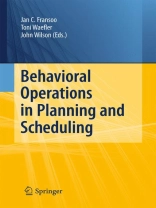Human and organizational factors have a substantial impact on the performance of planning and scheduling processes. Despite widespread and advanced decision support systems, human decision makers are still crucial to improve the operational performance in manufacturing industries. In this text, the state of the art in this area is discussed by experts from a wide variety of engineering and social science disciplines. Moreover, recent results from collaborative studies and a number of field cases are presented. The text is targeted at researchers and graduate students, but is also particularly useful for managers, consultants, and system developers to better understand how human performance can be advanced.
Inhaltsverzeichnis
Introduction.- Decision Making in Planning and Scheduling.- The Interconnectivity of Planning and Shop Floor: Case Description and Relocation Analysis.- The Unsung Contribution of Production Planners and Schedulers at Production and Sales Interfaces.- Collaborative Planning in Supply Chains.- Measuring Supply Chain Performance.- Planning Information Processing Along the Supply-Chain.- The Planning Bullwhip.- Product Centric Organization of After-Sales Supply Chain Planning and Control.- Building Decision Support Systems for Acceptance.- Design of Scheduling Algorithms.- A Comparison of Task Analysis Methods for Planning and Scheduling.- Allocating Functions to Human and Algorithm in Scheduling.- Design of Scheduling Algorithms.-Case Study: Advanced Decision Support for Train Shunting Scheduling.- An Open Source Encyclopedia and Debating Instrument for Planning Terms: The Hopsopedia.- A Sample of Hopsopedia Term Descriptions.
Über den Autor
Jan. C. Fransoo: Full Professor of Operations Planning and Control at Technical University Eindhoven, Netherlands Toni Waefler: Professor at the University of Applied Science, Olten, Switzerland John Wilson: Professor of Human Factors in the School of Mechanical, Materials and Manufacturing Engineering. He was founder and first Director of the University‘ s Institute for Occupational Ergonomics.












